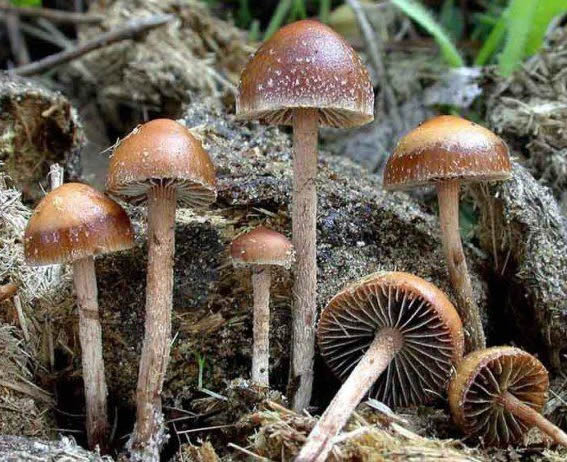 |
| Ustomycetes |
The Ustomycetes are a group of the basidiosporic fungi that includes about a thousand species. These fungi all produce spores in a sorus, amass of spores that is produced on the surface of a plant host.
Ustomycetes are all parasites of plants, and some are serious pathogens. Most produce hypertrophy (excessive cell growth) in plant tissues.
One of three main classes of Basidiomycota, the ustomycetes include several different orders. Cryptobasidiales is a small order of fungi found in tropical areas of South America and Africa.
  |
The only species in the Cryptomycocolacales is a parasite of ascomycetes. The Exobasidiales produce galls on leaf tissue of plants in the Ericaceae and Commelinaceae families. The Graphioales produce black sori on the leaves of Palmae.
The Platygloeales produce small gelatinous to waxy basidiocarps and are saprophytes or mycoparasites. The Sporidiales are yeast like saprophytic fungi. The remaining order, the Ustilaginales contains almost all of the fungi of the ustomycetes.
Reproduction
The reproduction of the ustomycetes begins when a haploid hypha from a germinating basidiospore combines with a compatible hypha from another germinating spore.
The resultant dikaryotic hypha then ingresses into the plant host. The hypha begins to parasitize the host, allowing the fungus to increase in mass. The fungus needs actively growing tissue to be able to reproduce.
After the fungus has gained sufficient energy, the hypha begins to fragment into small cells, which become thick-walled chlamydospores. These spores are dark in color and form the sorus.
The chlamydospores undergo genetic change, and a diploid nucleus is produced. The nucleus then undergoes meiosis and produces haploid nuclei.
The chlamydospore germinates, forming a small length of hypha called a metabasidium. The nuclei migrate into the metabasidium, and small basidiospores are produced. The basidiospores often form a yeast like phase as they reproduce by cell division.
This mechanism is unique among the fungi, as most spores, once formed, are unable to divide into two new units. Ustomycetes also have a yeastlike phase when they are grown in axenic culture. Spore release is passive.
The Smuts
The ustomycetes in the order Ustilaginales are important plant parasites, known commonly as smuts, and can affect most meristematic areas of plants. Some of these cause considerable economic damage to plants. The smuts cause hypertrophy (excessive growth) of growing tissues.
Infection is by dikaryotic hyphae that can penetrate into the meristems of ovaries, leaves, and even roots of plants. The resultant mass of cells can produce a large growth that is unsightly.
 |
| Corn smut caused by Ustilago maydis |
The Ustilaginales are divided into two families based on the location at which the basidiospores are produced on the metabasidium. In the Tilletiaceae, the spores are located terminally, while in the Ustilaginaceae, the spores are located laterally.
One of the more visible smuts is caused by Ustilago maydis, which infects corn. Corn smut has been recorded for thousands of years and is depicted in Mayan and Incan drawings of corn. The fungus infects the developing ovum by penetrating the silk at the time of pollination.
Pollination does not occur, but rather the fungus becomes established and fungal tissue begins to grow in place of the developing ovum. A mass of fungal tissue forms under the seed coat. The resulting gall can be more than an inch in length. These are often found on ears of corn as large gray or black growths.
Thousands of years ago, it was believed that these growths were divine in origin, and any infected ears were separated. The infected ears were then used as offerings in religious ceremonies. The smut galls were often consumed by the religious leaders.
   |
This practice may have preserved corn for future generations. Seed corn can become coated with chlamydospores at the time of harvest. These spores can germinate at the time of planting and infect the germinating seed. Death of the seedling is possible.
Other kinds of smut include bunt and stinking smut, which infect wheat. With bunt, the seed becomes infected but does not show any symptoms. The mycelium of the fungus remains dormant in the seed. The following year, as the seed germinates, the mycelium remains associated with the meristem.
When the wheat plant produces its inflorescence, the fungus causes sori to be produced instead of ovaries. With stinking smut, the chlamydo spores are transmitted on the surface of the seeds.
Basidiospores are produced, and the mycelium infects the developing plant. When the inflorescence is produced, the ovaries appear enlarged, and the “seed” produced will have a sorus occupying the entire interior. The sori have a distinctive dead fish odor, accounting for the name.
While many smuts attack ovaries, some smuts cause sori to be formed on leaves. Striped smut occurs on some turf grasses, while other smuts can cause spots on leaves of plants.
Most inflorescence smuts occur only once a year and do not affect more than about 5 percent of the seeds. They are disseminated by wind. They can be more damaging, however, if crops are staggered in the same growing season.